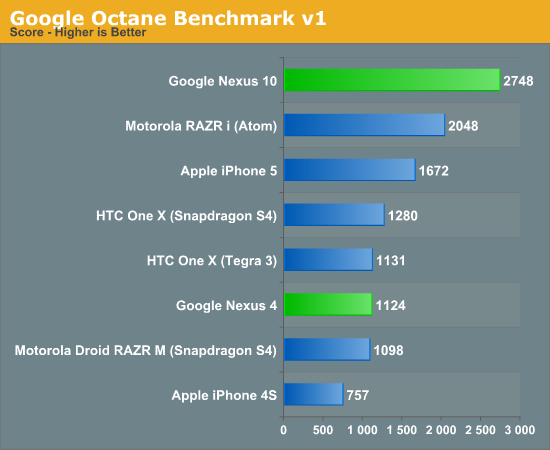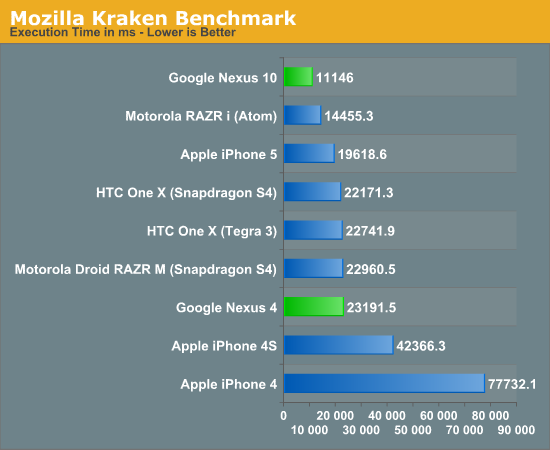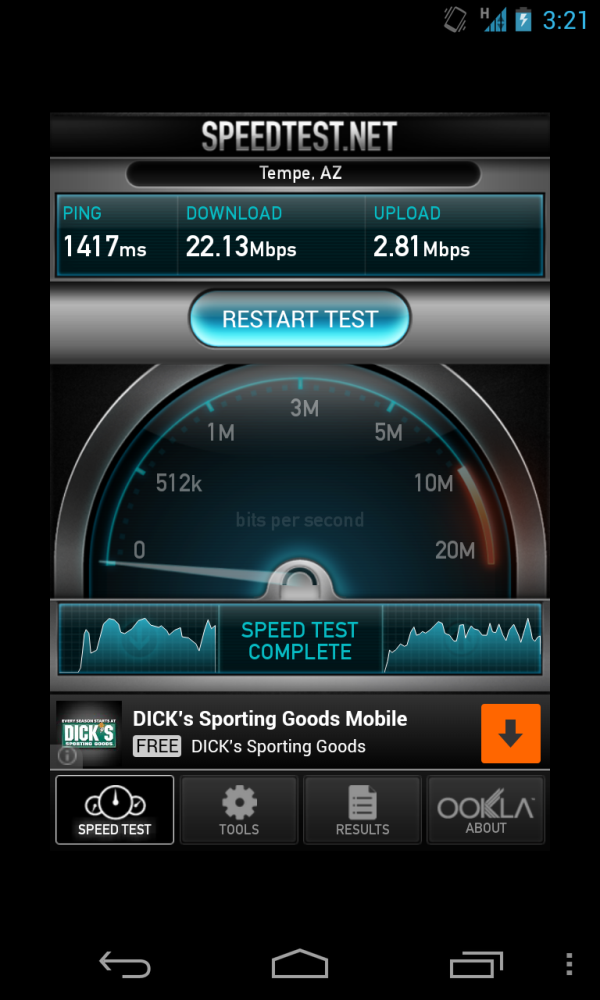Google Nexus 4 and Nexus 10 Performance Preview
by Anand Lal Shimpi & Brian Klug on November 2, 2012 11:00 AM ESTEarlier this week Google announced two new flagship Nexus devices: the Nexus 4 smartphone and the Nexus 10 tablet. We received review samples of both earlier this week, and while we're hard at work at full reviews of the devices we couldn't help but share all of the test data we've been able to amass at this point.
For those who aren't familiar with it, the Nexus 4 features Qualcomm's Snapdragon S4 Pro SoC - a quad-core 28nm Krait CPU with Qualcomm's next-generation Adreno 320 GPU. The combination proved quite formidable in the MDP/T we tested, as well as LG's recently announced Optimus G. The SoC drives a 4.7-inch 1280 x 768 IPS display and is paired with 2GB of LPDDR2 memory. The Nexus 4 ships unlocked with 8GB of NAND for $299 without a contract ($349 for the 16GB version). Pair that with DC-HSPA+ support and you get an absolute killer smartphone for use on T-Mobile: no contracts, very low monthly fees, and compelling cellular performance:
Brian will talk more about the combination in his full review, but rest assured that the lack of LTE is workable depending on T-Mobile coverage where you live/travel to.
The Nexus 10 also boasts a brand new SoC: Samsung's Exynos 5 Dual. The Exynos 5 Dual features two ARM Cortex A15 cores running at 1.7GHz as well as ARM's own Mali-T604 GPU. This happens to be the exact same platform used in the new Chromebook, just running Android. The Nexus 10 features a 10.1-inch 2560 x 1600 display, giving it the same resolution as the 13-inch MacBook Pro with Retina Display - but in an even smaller form factor. Google is also aggressive on Nexus 10 pricing: the 16GB WiFi-only tablet sells for $399, with the 32GB version going for $499.
Both Nexus devices run Android 4.2 and are guaranteed to be the first devices to be updated to upcoming Android revisions for the foreseeable future (it's the power of Nexus).
We haven't had a ton of time to test the devices and put this together so you're going to see combined performance charts throughout the rest of this article.
CPU Performance
The big story when it comes to CPU performance is a look at how the Cortex A15s perform under Android. Unfortunately we're still left with mostly browser based benchmarks to measure CPU performance, which actually highlights a major issue in our testing: Android V8 optimization doesn't seem to be anywhere near as good as it is under Chrome OS or Windows. As a result, all of the Nexus 10 performance scores end up slower than the new Chromebook - despite using the same SoC and running Chrome on both platforms. It's also possible that the Exynos 5 Dual in the Chromebook is allowed to burn a bit more power, translating to better performance, but either way the solution here in the Nexus 10 doesn't look as good across the board.

SunSpider performance is good, but not significantly better than Qualcomm's Krait based Snapdragon S4. Both the iPhone 5 and RAZR i are able to outperform the Nexus 10. The S4 Pro based Nexus 4 tends to be in line with other S4 based devices - SunSpider doesn't really give much credit to the extra 2 cores.

BrowserMark puts the Nexus 10 behind many platforms that should be faster, I'm even wondering here if there's some hard partitioning of memory bandwidth between the CPU and GPU to drive the 2560 x 1600 display that's simply choking the CPU here.
The Nexus 4 does ok, but again there seem to be some V8 optimization issues at work here under Android 4.2. At 1.5GHz it should deliver at least the performance of the dual-core Snapdragon S4 solutions.

Octane is the first test where the Cortex A15s are really able to flex their muscle - the Exynos 5 Dual based Nexus 10 manages to outperform the RAZR i by 34%, and compared to the A6/Swift based iPhone 5 the advantage grows to 64%.
The Nexus 4 performs about in line with other Snapdragon S4 based devices, although once again the extra 2 cores don't seem to be doing much for it here at all.

Kraken also paints the Cortex A15 based Nexus 10 in a good light: there's a 30% advantage over the RAZR i and a 76% advantage over the iPhone 5. These numbers will shrink a bit compared to other tablets, but not by much. The Nexus 4, once again, ends up performing similarly to dual-core Snapdragon S4 based devices.
Overall, the Nexus 10 results show us some real promise for what we can expect from ARM Cortex A15 based SoCs. The potential upside to this new architecture is huge.

















244 Comments
View All Comments
UpSpin - Saturday, November 3, 2012 - link
The iPhone/iPad score almost double the numbers of their competitors in Offscreen- Fill test
- Triangle Texture Test
- Triangle Texture Test - Fragment Lit
- Triangle Texture Test - Vertex Lit
Yet in the HD Offscreen benchmark both the iPhone and iPad score averagely.
I think we can safely conclude:
Those Fill/Triangle Test are meaningless. So why on earth do you post them? Or tell us the use of them.
If a device scores exceptional in those, it still can deliver medioce 3D performance, so those benchmarks say NOTHING.
If I have a car with a motor which can spin 100.000 rpm if the tires are lifted in the air, but on the road, it can't spin faster than 1000rpm, you know what? Then the 100.000rpm in air is meaningless.
Because of the huge number of meaningless charts (Fill/Trinangle) in your preview they just make everything confusing, and make it hard to compare the real performance of the devices.
krumme - Saturday, November 3, 2012 - link
Agree. This kind of mess must stop now, its very difficult to interprete the results.Solution:
I would prefer, the method used in the recent cromebook where you compared in the same software platform. A very seldom straight review that i appriciated very much.
Meaningless benchmark with little resemblance to practical usage must be omitted.
I know it probably means less numbers and bm, but so be it. It will improve in time. I know it cost tons on money to develop propor independant benching. But the Anand own sdd bm suite was a huge step forward for evaluating ssd, and really made Anandtech stand out as hands down the best site for the ssd stuff. We need something of that caliber.
This nonsense just leads to wrong interpretations and buying decicions, and can influence the development in wrong ways, meaning less money for real development and more for technical marketing.
Krysto - Saturday, November 3, 2012 - link
Agreed, those numbers do seem pretty much useless. Even if the GPU's can go that high in those benchmarks, they're probably bottlenecked by something else in the system, which makes the extra performance in those specific benchmarks pointless, and this is why the iPad scores much lower in the "full graphics tests" like Egypt HD, etc.juicytuna - Saturday, November 3, 2012 - link
These graphs are getting abused all over the internet. I saw an article yesterday where the author used a solitary triangle texture test graph to show the iphone / ipads superior graphics performance over rivals Beggars belief really.I think Anandtech needs to educate its reader base more on what these low level tests actually mean and how they are rather meaningless in the context of real world performance.
Perhaps putting them into tables rather than giving them a pretty graph might help too.
Filiprino - Saturday, November 3, 2012 - link
Yep. The Nexus 10 although using a basic Mali T600, has a good score in the Egypt Benchmark.tytung - Sunday, November 4, 2012 - link
I don't think so.Cars with a higher hypothetical rpm in the air would almost certainly perform better than those that can't even perform well in the air.
BTW, iPad/iPhones are highly tweaked to perform well under real life circumstances and user experience.
-sandro- - Saturday, November 3, 2012 - link
How is it possible iPhones always win in 3G/WIFI web browsing battery life? Is it that difficult for Android to make a phone last 10 hours in wifi like Apples does?vision33r - Saturday, November 3, 2012 - link
Android was not optimized with hardware as well since Apple has full control of both hardware and software designs. Even Nexus Phones, Google does not do any hardware designs.They will never reach the hardware software intimacy that a company like Apple can achieve.
The gap will widen when hardware gets faster and become more power hungry and Apple will be even more efficient with their software than the rest.
Google needs to understand at some point they need to get involved in the chip and hardware design in order to maximize their software optimizations.
UpSpin - Saturday, November 3, 2012 - link
Then tell me how HTC was able to deliver such a good battery life (according to AT) whereas they used a smaller battery than the Nexus 4 does. One does not have to make his own processor to achieve a better battery life.The browser ratings are pretty bad, what AT did was a browser battery rundown. So page rendering was probably more CPU intensive on the Nexus 4 than on other smartphones. If the browser gets improved, so will the battery life, too.
Maybe their review unit is defective, too (overheating, low battery life, poor results compared to reviews like TheVerge)
And finally, you shouldn't forget, that Android allows any background tasks to be active. iOS not, with their 'pseudo multitasking'. This gives iOS a huge advantage (far easier process managment, less memory needed, less CPU ressources wasted) but the user suffers.
Still, the battery life of the Nexus 4 doesn't look great, and I doubt that those numbers are correct, especially because TheVerge praised the Nexus 4 battery life.
Would be interesting to see the battery life of the identical (yet according to AT much more powerful) LG Optmius G. if it's much better, than their review unit is broken and/or the browser in Android 4.2 is broken.
Jorange - Saturday, November 3, 2012 - link
Dear Anand and Brian.I am slightly worried that Anandtech is not treating all devices on a level playing field. You mention that the Optimus G could not complete the entire GLBenchmark test consecutively, as it crashed due to running out of memory or such like, so the benchmarks must have been run individually?, a far less taxing task than completing the entire benchmark in one run that Nexus 4 managed, hence the FPS were lower as the SoC hit thermal limits, which paints a poorer picture of the Nexus 4.
For the sake of openness and to dispel any talk of favoritism, could you please confirm whether the iPhone 5 / iPad GLBenchmark scores were the result of 1 serial run through the entire suite or multiple independent tests. I tried to run all test in one go on my Nexus 7 and it crashed, so if Apple devices can mange this feat, it would be cool to known the rationale for this, if not, then surely the Nexus 4 should be tested under the exact same methodology as any all other devices. Would you consider Linpack as an addition to your usual rigorous test suite.
Looking forward to your reply
Joe